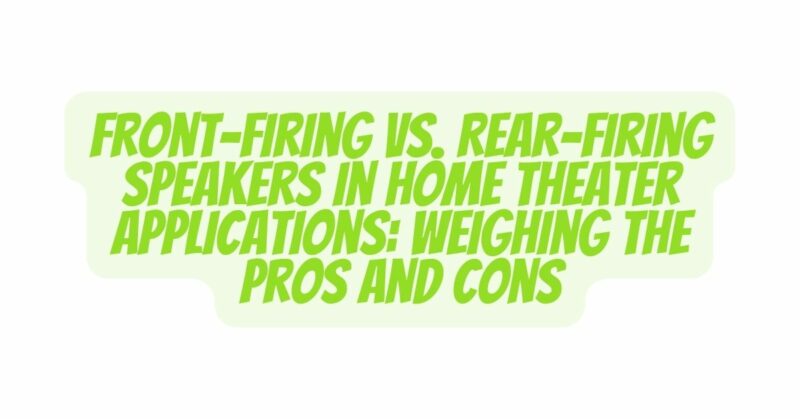When setting up a home theater system, the placement of speakers significantly impacts the audio experience. Front-firing and rear-firing speakers serve different purposes and have distinct advantages and disadvantages. Understanding the characteristics of each type can help you make an informed decision about the ideal speaker placement for your home theater setup.
Front-Firing Speakers: Advantages and Disadvantages
Advantages:
- Direct Sound Projection: Front-firing speakers are designed to project sound directly towards the listener. This results in clear and focused audio that’s well-suited for dialogue, vocals, and instruments.
- Localization and Imaging: With front-firing speakers, it’s easier to pinpoint the source of the sound. This is particularly important for creating a realistic and immersive soundstage, where you can accurately perceive the location of different audio elements.
- Optimal for Dialogue: In home theater setups, the center channel speaker is often front-firing and positioned near the screen. This arrangement ensures that dialogue and on-screen sound effects are projected directly at the audience, enhancing speech clarity.
- Accurate Soundstage: Front-firing speakers contribute to a well-defined soundstage where the audio feels anchored and balanced across the front of the room.
Disadvantages:
- Limited Sound Dispersion: Front-firing speakers may have limited dispersion patterns, which means they might not evenly cover the entire room with sound. This can result in some listeners experiencing better audio quality than others in larger seating areas.
- Less Reflective Sound: Front-firing speakers deliver sound directly to the audience, which may result in a lack of natural reverberation and room acoustics. This can reduce the sense of spaciousness in the audio experience.
Rear-Firing Speakers: Advantages and Disadvantages
Advantages:
- Enhanced Surround Sound: Rear-firing speakers, also known as surround speakers, are designed to create an enveloping audio experience. They contribute to immersive sound effects that place the viewer in the midst of the action.
- Spacious Audio: Rear-firing speakers introduce reflected sound that interacts with room acoustics, creating a more spacious and natural audio environment.
- Expanded Soundstage: Rear-firing speakers widen the soundstage, making it feel larger and more encompassing, which is especially beneficial for movies and immersive gaming experiences.
Disadvantages:
- Localization Challenges: Rear-firing speakers can sometimes make it harder to localize the source of sound. This might result in less precise imaging, making it difficult to pinpoint the direction of audio elements.
- Interference with Room Design: Rear-firing speakers require careful placement to avoid obstructing furniture, décor, or other objects that could impact sound dispersion.
Choosing the Right Mix for Your Setup:
The ideal speaker configuration depends on the layout of your home theater room, your audio preferences, and the immersive experience you aim to achieve. In many setups, a combination of front-firing and rear-firing speakers is used to strike a balance between accurate localization and immersive surround effects.
A well-designed home theater system considers the advantages and disadvantages of both front-firing and rear-firing speakers. The goal is to create a harmonious audio environment that complements the visuals on the screen and enhances the overall entertainment experience. Whether you prioritize clear dialogue, precise imaging, or immersive surround effects, the careful arrangement of your speakers will ultimately determine the magic of your home theater’s audio performance.


